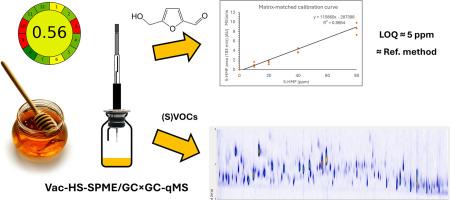Enhancing the targeted and untargeted analysis of honey by vacuum-assisted SPME-GC × GC-MS. A green, practical, and highly informative approach
IF 6.2
引用次数: 0
Abstract
The use of vacuum-assisted headspace (Vac-HS) coupled with solid-phase microextraction (SPME) is a technique that has been recently proven to be highly beneficial for enhancing the extraction of semi-volatile in shorter time and milder temperatures. This technique indeed increases the extraction kinetics by reducing the mass transfer resistance at the interface between the sample and headspace. In this work, we explored the use of Vac-HS coupled with comprehensive two-dimensional gas chromatography coupled with mass spectrometry to simultaneously determine 5-hydroxymethylfurfural (a semi-volatile processing marker in honey) and the entire volatile profile, which is recognized as a highly informative fingerprint of the geographical and botanical authenticity of honey. The use of Vac-HS-SPME has been optimized using an experimental design and compared to the atmospheric pressure extraction. Considering both 5-HMF and the entire volatile profile, an overall 10-fold higher signal was obtained using Vac-HS-SPME compared to simple HS-SPME. The absolute quantification of 5-hydroxymethylfurfural was fully validated, obtaining a limit of quantification of about 5 µg/g, largely below the lowest required limit for the presence of this compound in honey (i.e., 15 µg/g). The results obtained from a series of commercially available honey were compared with those obtained using the official high-performance liquid chromatography-UV method, obtaining comparable results but through a greener and more practical method. The overall volatile profile obtained by Vac-HS-SPME showed a significant increase in the response of the less volatile compounds, reaching up to a 90-fold increment compared to HS-SPME.

真空辅助SPME-GC × GC-MS对蜂蜜的靶向和非靶向分析。这是一种绿色、实用、信息丰富的方法
真空辅助顶空(Vac-HS)与固相微萃取(SPME)相结合是一种最近被证明在更短的时间和更温和的温度下对半挥发性成分的提取非常有益的技术。该技术确实通过减少样品和顶空界面处的传质阻力而提高了萃取动力学。在这项工作中,我们探索了使用vachs结合综合二维气相色谱联用质谱同时测定5-羟甲基糠醛(蜂蜜中的半挥发性加工标记物)和整个挥发谱,这被认为是蜂蜜地理和植物真实性的高信息指纹。通过实验设计对真空- hs - spme的使用进行了优化,并与常压萃取进行了比较。考虑到5-HMF和整个挥发性谱,与简单的HS-SPME相比,使用Vac-HS-SPME获得的信号总体高10倍。5-羟甲基糠醛的绝对定量得到了充分验证,定量限约为5µg/g,大大低于蜂蜜中该化合物存在的最低要求限(即15µg/g)。将从一系列市售蜂蜜中获得的结果与使用官方高效液相色谱-紫外法获得的结果进行了比较,得到了相似的结果,但采用了更环保、更实用的方法。Vac-HS-SPME获得的总体挥发性谱显示,挥发性较低的化合物的响应显著增加,达到HS-SPME的90倍。
本文章由计算机程序翻译,如有差异,请以英文原文为准。
求助全文
约1分钟内获得全文
求助全文

 求助内容:
求助内容: 应助结果提醒方式:
应助结果提醒方式:


